It’s REALLY EASY to make apple cider vinegar from scraps. Waste not, want not and all those thrifty proverbs are perfect for this recipe. The result is a light and refreshing vinegar that is probiotic! So get thrifty with this zero-waste recipe and turn your apple scraps into something useful!
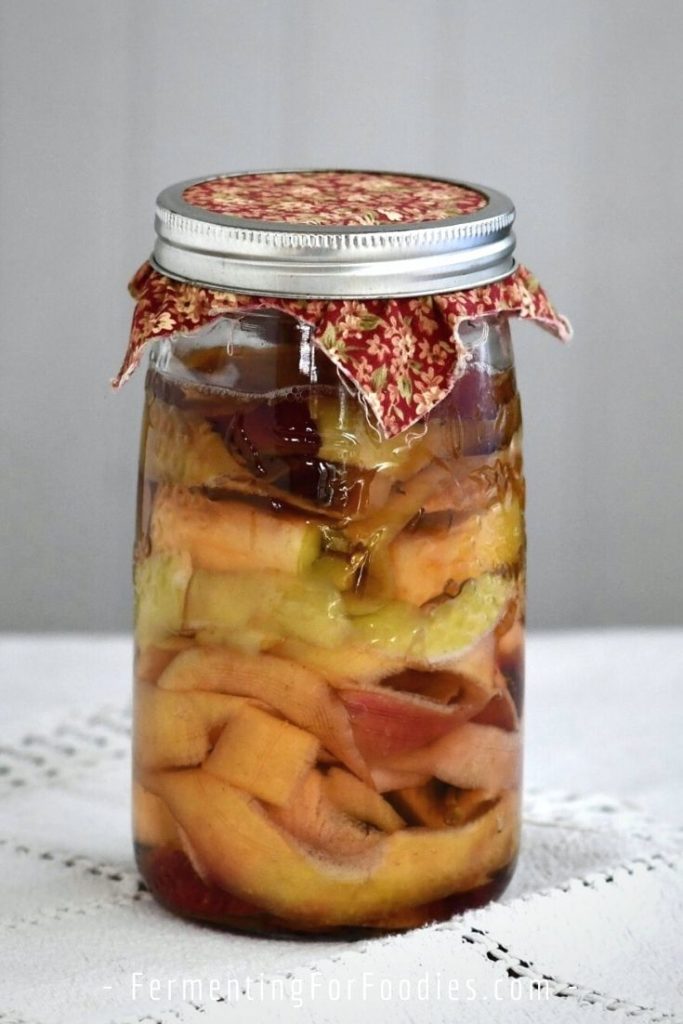
Scrap apple cider vinegar
Apple cider vinegar from scraps is different from traditional ACV. It is a bright and fresh vinegar compared to the earthy, full flavor of traditional cider vinegar.
Here’s what you can expect from scrap apple vinegar:
- Perfect for adding tanginess to cooked recipes.
- Use it in salad dressing or as a health tonic.
- It is probiotic! So it can be used to culture other foods.
- I love it for making shrubs. The slightly lower acidity makes it perfect for adding flavor to a drink.
- Don’t use it for canning, unless you test the pH. Otherwise, you don’t know the exact acidity levels. You need a pH of 5 for more canned foods.
For a more traditional apple cider vinegar, here’s how to make cider vinegar from juice.
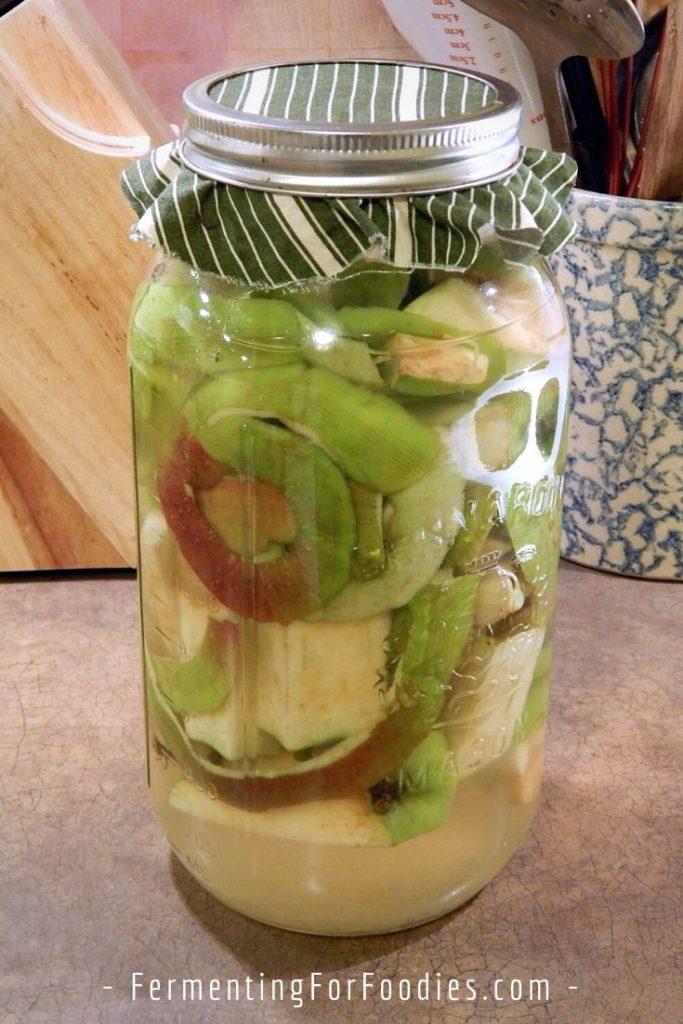
Your Questions Answered
I’ve been making apple cider vinegar from scraps for years. It’s a really reliable ferment that is perfect for beginners. Here are some answers to common questions about homemade scrap apple vinegar.
- Scrap apple vinegar doesn’t need to start with a mother. However, it is the most reliable way to get a good ferment. It’s also really easy to find cultured cider vinegar. Usually real, cultured ACV is more expensive, however, once you have the culture you can make your own! See the notes in the recipe for a few different cultured vinegar brands.
- Don’t make this vinegar in a closed jar. It needs oxygen to properly ferment. I generally make my ACV as described in the recipe, with a piece of cloth held in place with a jar ring.
- I’ve never had a failure with my ACV. However, I have had a vinegar pellicle grow on top. It’s a SCOBY that forms sometimes and won’t harm the vinegar at all. It can even be used as a starter for future batches of vinegar!
- Kahm yeast also really likes scrap apple vinegar. Don’t worry, it will die off when the sugar is gone and the vinegar becomes acidic.
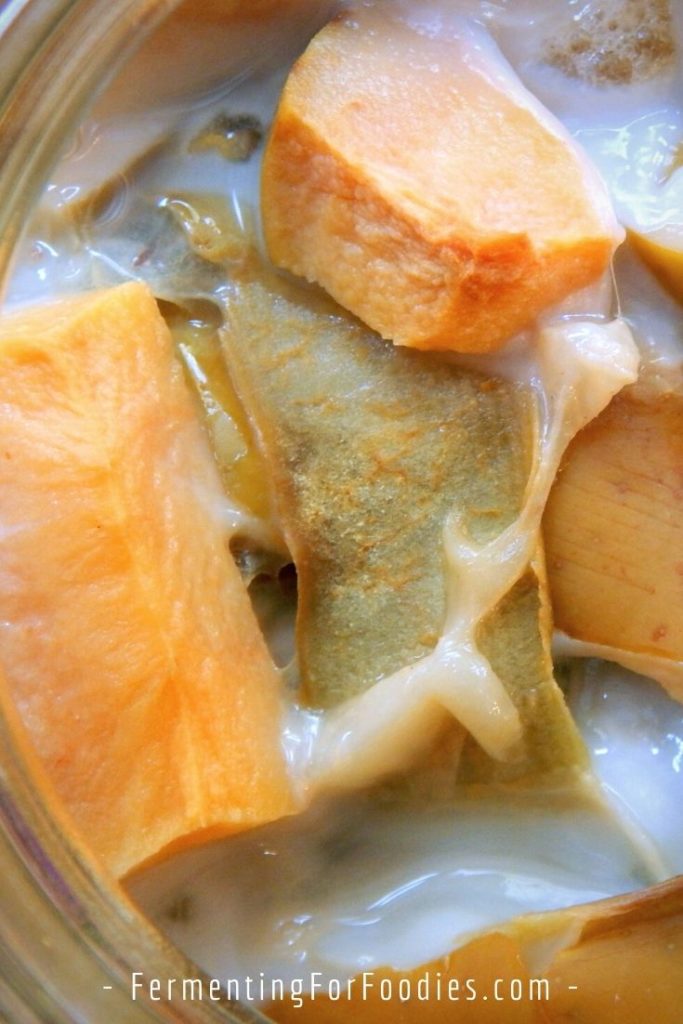
Scrap Apple Cider Vinegar
Apple cider vinegar made from scraps is delicious and full of probiotics. It’s a great way to use up apple cores and peels. Perfect when making apple sauce or apple pie!
- Prep Time: 15 minutes
- Total Time: 15 minutes
- Yield: 1 quart jar 1x
- Category: Condiment
- Method: Fermented
- Diet: Vegan
Ingredients
- Apple scraps (peels and cores; bruises are OK but no rotten bits)
- 1 cup water (chlorine-free)
- 1 Tbsp sugar per cup of water
- 1 Tbsp of apple cider vinegar with a mother per cup of water
Instructions
- This recipe is designed so you pack jars with apple scraps, then add as much water and sugar as you need to cover them. Adjust the measurements to suit the amount of apple scraps you have.
- Wash your apples before peeling them, then fill a glass jar 3/4 full of apple scraps. Just make sure the scraps are free of mold and bad spots.
- Mix the sugar, water and culture 1 cup at a time, then pour it over the apple scraps. Keep adding more cups of water, sugar and mother until you have just covered the apple scraps.
- The apple scraps will float, and that’s just fine. Cover the jar with a piece of cloth or a coffee filter and keep in place with an elastic band or jar ring. Do not use a sealed jar as it needs oxygen to properly ferment.
- Place the jar somewhere dark to ferment at room temperature. A closet is perfect.
- Check it every 2 to 3 days to stir.
- After 2 weeks strain out the scraps leave it to continue fermenting in jar covered with a piece of cloth for another month before bottling it. I usually let my vinegar age for at least 6 months. It will continue to age and darken and the flavor will improve.
Notes
- The vinegar may grow a thick rubbery pellicle, and/or there might be dark floating bits. Both of these things are fine. Mold is not OK… If you get mold then throw it out and start again. See the section above for more details.
- The vinegar will continue to ferment until all of the sugar is gone. So if it doesn’t taste sour after a month of fermenting, feel free to leave it for another 2 or 3 months.


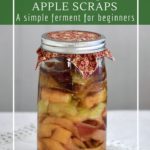

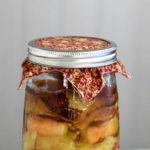
This was a great way to use up the apple scraps from making apple sauce. Super thrifty! And so much cheaper than buying ACV. Thanks!
Great! It’s a go-to recipe for me too!
can you use an airlock like a pickle pipe for this? or does it need oxygen for the ferment? thanks!
You can use an airlock, but only if you are certain that your cider vinegar has a healthy mother. Otherwise it needs the free-range yeasts in your home to ferment.
thanks!!
a bunch of thanks to the recipe. I am sure gonna try it the soonest. More power!
Thanks!
How do you prevent mold? I’ve done 2 now and both times, I’ve had it mold ♀️ Thanks so much for the help
Kylee, I’m sorry to hear that you’ve lost two batches of scrappy ACV. I only ever had mold once, and I was using apple scraps that I had collected and frozen. Now I just make it every fall with fresh apples. Here are my suggestions for preventing mold:
1. Do you have mold in your house? If that’s an issue, then you’ll want to use a fido or airlock to prevent contamination. I know I suggest starting with open air fermenting, but it should still ferment if you start with a good ACV culture.
2. Clean out your jar by filling it with boiling water and leaving it for 5 minutes. That should kill any mold in the jar.
3. Lastly, only use good apple scraps. Wash the skins before you peel the apples and compost any spots that look off. Cores and peels are fine as long as they aren’t bruised and moldy.
Good luck!
You can also prevent mold by using a weight to keep all the scraps under the sugar water. If you don’t have a weight you can fill a bag with water and place it on top.
How do you store your mothers when not in use and how long can you store them without using them?
I can not see how to subscribe could you add me to your mailing list please?
I just leave them in the cider vinegar, then transfer them when I make a new batch of vinegar. I admit that I have 4-5 containers of AVC at any given time. If I have too much mother, then I just mix it into a salad dressing.
At the moment, I don’t have a mailing list. With all the new data protection laws, I’m not super keen to keep a list of email addresses. However, I do post all my new content on facebook, instagram and pinterest. So feel free to follow me there!
How long does the vinegar stay good?
I usually use up my vinegar within 1 year, and I’ve never had it go off. I imagine it could last several years provided you got to the right pH level. Enjoy!
Could I use pulp from juicing apples?
Yes! Just try to get them into the jars for fermenting right after pressing. You want to minimize the oxidation (browning).
Can scrap apple cider vinegar be used for making herbal tinctures just like traditional acv?
Yes! It’s cultured and acidic, just like traditional ACV. However, unless you test the pH, you won’t know exactly what the acidity is. Does the precise acidity matter for your herbal tinctures?
once it’s been like 6 weeks do u need to do something different to stop the process or will it stop by it self?
Hello, The vinegar will stop fermenting on its own when the sugar is all used up. Usually this takes up to 2 months, but could take longer if your house is cool. I recommend aging it for a few months for better flavor.
Cheers, Emillie
is it ok to transfer two batches of scrap apple vinegar into each other? they were made about a week apart.
thanks.
Yes! As long as both batches worked well, that should be fine. I often make a bunch of small batches then combine them at the end. Though every now and then I end up with a batch that got kahm yeast so that one stays separate.
I put some fresh apples which were turning soft cut up (without seeds), in water, sugar and covered with a coffee filter. Put it on my counter (last Sept), not in dark. I stir it periodically. Never drained it (read drain when the fruit falls to bottom of gallon container). A few days ago it started to begin to sink and become kinda cloudy. Today I noticed a scoby has filled the top. I did not know Vinegar would do this, and thus that is how I found your website. What should I do now? How can I use this… should I begin again with the Scoby and fresh apples? I started this at a friends suggestion, as she suggests I take a table spoon of Vinegar with a Mother daily for my health. Can I drain the fruit and do that even though a Scoby is floating on top? Is it ready? I have been reading up on making Kombucha and have a Kombucha recipe book, can I use this fermentation juice in lieu of the Kombucha juice and use it in that way?
Hi Bren, Glad to have you on the site! The SCOBY is not an issue, so your vinegar is fine. Just strain it into a clean jar and let it age for a bit longer. I usually age my vinegar for at least 6 months, but it’s up to you. You could use the SCOBY to make more scrappy apple cider vinegar. However, it is not the same as a kombucha SCOBY. Cheers, Emillie
I have a good tree in the backyard when my apples fall of I use them instead of the scraps i just wash them cut up small and follow the recipe been in the jar 2 weeks now and can smell the vinegar just a bit cloudy at the moment do I now seal it with a top it’s now in a plastic Pop bottle.
I have a Braggs that has formed a SCOBY. Can I add the SCOBY to my jar as well? Is there any benefit? Will it speed up the process at all?
Oh wait, I see you answered someone else that you can use the SCOBY to make scrap vinegar!
Yes! I actually get a SCOBY on my ACV about once every few years. 🙂 I think it’s more likely if you have other SCOBYs in your home. Enjoy!
Thank you!
Thanks for putting up this recipe. Is it ok to still stir which means breaking up the white fillm / SCOBY that has formed on top?
It’s totally fine to break up the pellicle that’s formed on top of your vinegar… in fact, it’s necessary for this recipe! It will probably grow back within a week and it suggests you have a good ferment going. Cheers! Emillie
Can honey in equal amount be used instead of sugar?
Hi Lisa,
There are two issues with swapping honey (or any other sweetener) in this recipe. 1. The yeast in ACV feeds on sucrose. So regular sugar or coconut sugar is fine. Honey is a mix of glucose-fructose, so it won’t properly feed the yeast. 2. Raw honey naturally has its own bacteria and yeast culture. So it will ferment into mead first. Mead can ferment into vinegar, it just won’t be the same flavor as typical ACV.
If you are concerned about consuming sugar, I can assure you, that there really isn’t any left in the final product. If you happen to have a lot of raw honey, then feel free to use it and turn this recipe into a mead-based variation!
Cheers, Emillie
Once it is done and strained does it need to be refrigerated or is it pantry safe to store?
Nope! The vinegar is shelf-stable, just like all other kinds of vinegar. However, you do need to let it fully ferment with a cloth or coffee filter cover for at least 1 more month after straining. Otherwise, the acetic acid bacteria won’t be able to do their work. Cheers!
After fermenting the liquid for 6 months in the closet with a coffee filter top, I have what looks and smells like a healthy ferment. It has a mother and a pellicle, which is now dropping down since I moved it. Do I strain it now and then let it sit in the closet again for another month or do I refrigerate it without staining the mother out? I just want to make sure I’m finishing it off properly. Thank you so much!
Hurrah! It sounds like a great batch of scrap ACV. When I’m ready to start using it, I just strain it into a bottle and store it in the cupboard with my other bottles of vinegar. It may grow a mini-pellicule, but after 6 months, it’s probably done fermenting. Enjoy!
Hi! I’m going on a month here with no bubbles! This is my second batch apple scrap vinegar and the first one was perfect! I thought maybe it was too cold in my house so I bought a seed warming mat. Two more weeks, still no bubbles. Any suggestions? Should I “scrap” it and start over?
Hi Sarah, Bubbles in a vinegar ferment shows good yeast action. However, no active bubbling isn’t necessary an bad thing. It could be that the acetic acid bacteria are working hard as well. If you don’t see mold, it’s probably fine.
Two things to check: are you leaving the ACV exposed to the air? It needs oxygen to properly ferment. (Another reason why you might not see bubbles is that they aren’t being caught). Give it a good stir and lick the spoon. Has it started to acidify or does it still taste sweet?
Good luck! Emillie
I took the glass weights out, stirred and tasted! It’s so good and no mold! Still a tinge sweet, but vinegar is in the works! I’m going on a month with the scraps still submerged. How much longer before I drain the scraps and store?
You can strain the apple scraps and let the ferment finish up (it will take 1 or 2 more months). Just be sure to keep it covered with cloth throughout this process. Enjoy!